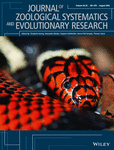Journal list menu
Export Citations
Download PDFs
Cover Image, Volume 56, Issue 3
- Page: i
- First Published: 05 July 2018
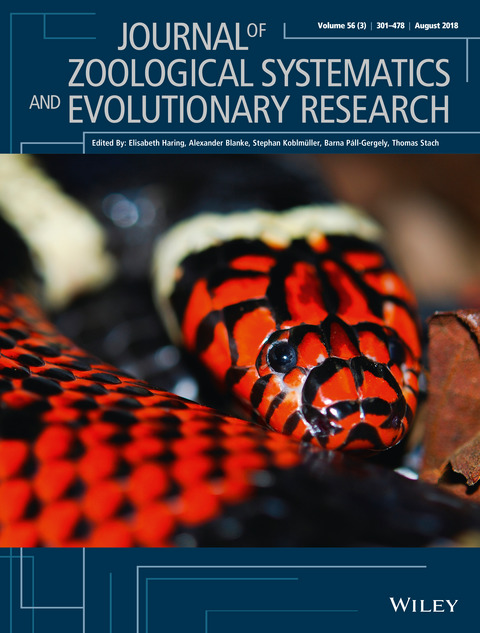
The cover image, by Fernanda Magalhães Silva et al., is based on the Original Article Aquatic adaptations in a Neotropical coral snake: A study of morphological convergence, DOI: 10.1111/jzs.12202. Photo credit: Diego Meneghelli.
A synthesis on cave-dwelling spiders in Europe
- Pages: 301-316
- First Published: 04 December 2017

We present the first overview on cave-dwelling spiders in Europe, including a detailed checklist of the European species. European caves yield the remarkable diversity of nearly 500 species. At least 200 species are confined to the deep subterranean domain, showing adaptations such as depigmentation and loss of eyes. From a biogeographic perspective, southern Europe emerges as the main hot spot of subterranean spider diversity.
Polymorphism of a genital organ under sexual selection in Monacha kuznetsovi from the Caucasus (Gastropoda: Hygromiidae)
- Pages: 317-322
- First Published: 25 March 2018
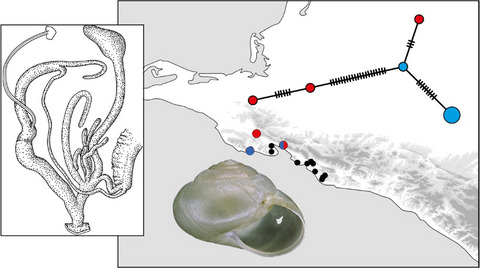
The dart apparatus of helicoid land snails is under sexual selection, but has been lost in many lineages, presumably because natural selection counteracts sexual selection. Monacha kuznetsovi is here suggested as a suitable model organism to study how the interplay between sexual and natural selection may affect the evolution of the dart apparatus as it is one of only few species that is polymorphic with regard to the presence or absence of the appendicula, a homologue of the dart sac.
Speciation of silverside Chirostoma attenuatum (Pisces: Atheriniformes) in Central Mexico
- Pages: 323-334
- First Published: 12 March 2018
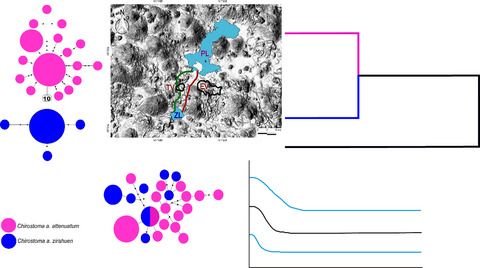
We studied the speciation in slender silverside Chirostoma attenuatum using phylogenetic and phylogeography approach with mitochondrial and nuclear markers. Our result suggests two speciation stages: early allopatric isolation, during which the isolated population accumulated unique adaptations, and secondary contact with low migration rate and the maintenance of the evolutionary trajectory resulting both population in two evolutionary independent lineages with independent demographic history with unique and irreplaceable genetic diversity that must to be conserved.
Diversification and biogeographic history of the Western Palearctic freshwater flatworm genus Schmidtea (Tricladida: Dugesiidae), with a redescription of Schmidtea nova
- Pages: 335-351
- First Published: 12 March 2018

We provide the first detailed morphological account of Schmidtea nova and present the first well-resolved molecular phylogeny for the four species of the genus Schmidtea, endemic in the Western Palearctic. The results corroborate that in this genus chromosomal rearrangements may be the main drivers of speciation. The genus would have originated in Laurasia, but lost its diversity during the Oligocene and reached its present distribution as the result of the expansion of three relictual species over Europe after Pleistocene glaciations.
Evolutionary insights into the North American Necturus beyeri complex (Amphibia: Caudata) based on molecular genetic and morphological analyses
- Pages: 352-363
- First Published: 13 December 2017

Necturus beyeri (Caudata: Proteidae), as conceived by some, contains paedomorphic salamanders distributed from the Ochlockonee drainage of Florida to the Angelina drainage of Texas. We used molecular and morphological data to infer phylogenetic relationships and morphological changes among drainages. We demonstrate that this lineage originated in the eastern portion of its range, spreading west and that N. alabamensis and N. maculosus are embedded within it. We infer that the lineage became progressively larger and more colorful as it moved westward.
Cryptic diversity and molecular systematics of the Aegean Ophiomorus skinks (Reptilia: Squamata), with the description of a new species
- Pages: 364-381
- First Published: 24 January 2018
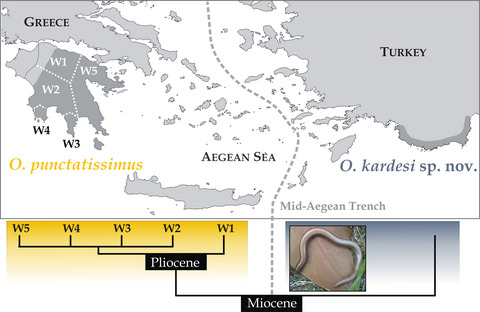
We used multilocus genetic data and thorough sampling to delimit species within Ophiomorus punctatissimus. Phylogenetic analyses revealed high levels of genetic diversity, suggesting the occurrence of at least two species, east and west of the Aegean Sea. We formally recognise the east Aegean populations as a separate species and provide a differential diagnosis based on DNA diagnostic characters. Interestingly, single-locus and multilocus coalescent methods of species delimitation support at least two and up to five species within the western O. punctatissimus.
Aquatic adaptations in a Neotropical coral snake: A study of morphological convergence
- Pages: 382-394
- First Published: 04 December 2017
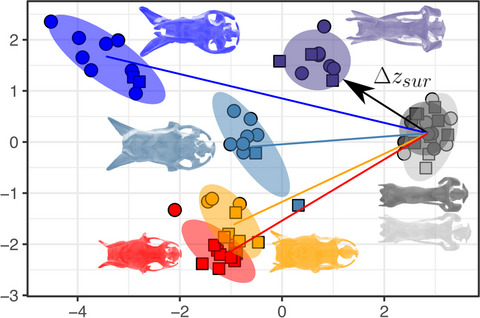
We analyzed external (head and body) and skull shape morphologies of the coral snake Micrurus surinamensis, comparing it with two terrestrial species of the genus and two aquatic and terrestrial species of distantly related groups. Results show that M. surinamensis is convergent with aquatic species mainly in the skull shape by having a longer supratemporal and quadrate bones than in terrestrial Micrurus. A more kinetic skull combined with a larger gape allows M. surinamensis to feed on fish, a wider prey than those which compose the main diet of other species of this genus.
Hidden in the Arabian Mountains: Multilocus phylogeny reveals cryptic diversity in the endemic Omanosaura lizards
- Pages: 395-407
- First Published: 06 February 2018
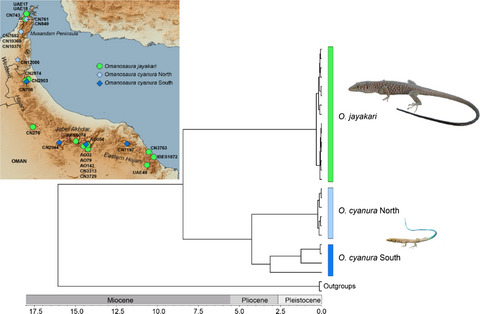
The two species of the lacertid Omanosaura, endemic to the Hajar Mountains, were genetically understudied. Phylogenetic analyses based on multilocus approach including haplotype reconstruction, concatenation, and species tree analyses revealed little genetic diversity within O. jayakari, while O. cyanura presents two differentiated lineages. These are reciprocally monophyletic at mitochondrial and nuclear genes, present a high genetic distance between them, and are associated with the geographical features of the Hajar Mountains, evidence suggesting the existence of cryptic diversity within O. cyanura.
Phylogeography of the Oenanthe hispanica–pleschanka–cypriaca complex (Aves, Muscicapidae: Saxicolinae): Diversification history of open-habitat specialists based on climate niche models, genetic data, and morphometric data
- Pages: 408-427
- First Published: 23 January 2018
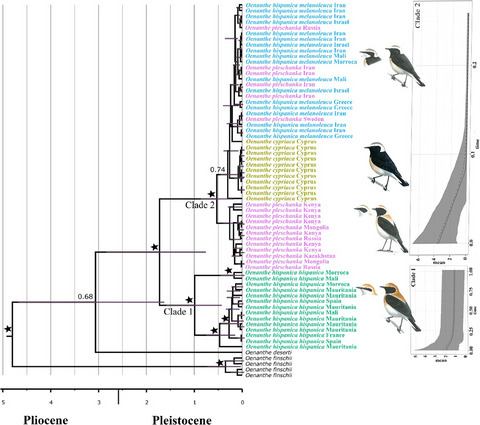
We studied the diversification of the Oenanthe hispanica-pleschanka-cypriaca (Aves, Muscicapidae: Saxicolinae). Two mitochondrial clades were revealed which diverged around 1.7 million years ago: one corresponding to O. h. hispanica, the other to O. cypriaca, O. h. melanoleuca, and O. pleschanka lacking consistent genetic differences. This might be explained by hybridization between the latter two in contact zones. Population expansions in the second clade coincided with the last glacial as expected for open-habitat birds and were also supported by climate niche models.
Positive selection on the mitochondrial ATP synthase 6 and the NADH dehydrogenase 2 genes across 22 hare species (genus Lepus)
- Pages: 428-443
- First Published: 09 January 2018
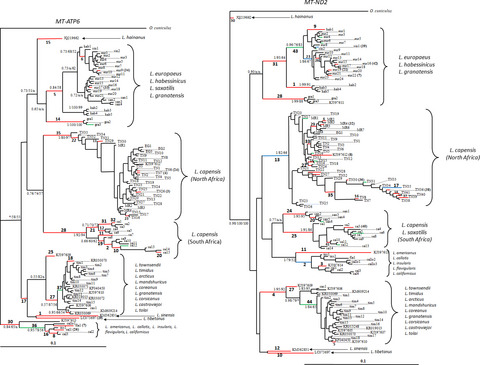
Site and branch-based tests revealed positive selection on MT-ATP6 and MT-ND2 sequences of 22 different hare (Lepus) species from a wide range of habitats and climates. Moreover, a significant climate effect on the presence of MT-ND2 protein variants was found. Our results are in line with earlier findings along a steep ecological gradient in North Africa and suggest complex effects of various climatic parameters acting on mtOXPHOS genes in a co-adaptive way, favouring combinations of ancestral and derived protein variants.
Molecular phylogenetic analyses indicate paraphyly of the genus Hybomys (Rodentia: Muridae): Taxonomic implications
- Pages: 444-452
- First Published: 14 February 2018

We combined mitochondrial and nuclear DNA sequence data to test the monophyly of the rodent genus Hybomys and to assess the specific status of H. eisentrauti and H. rufocanus. Our results highlight the paraphyly of the genus. Combined with previous morphological findings, Typomys and Hybomys should be considered as two distinct genera. We propose to consider H. rufocanus as a valid species, distinct from H. univittaus, and to consider H. badius and H. eisentrauti as its junior synonyms.
Historical and ecological influence in the evolutionary diversification of external morphology of neotropical spiny rats (Echimyidae, Rodentia)
- Pages: 453-465
- First Published: 06 March 2018
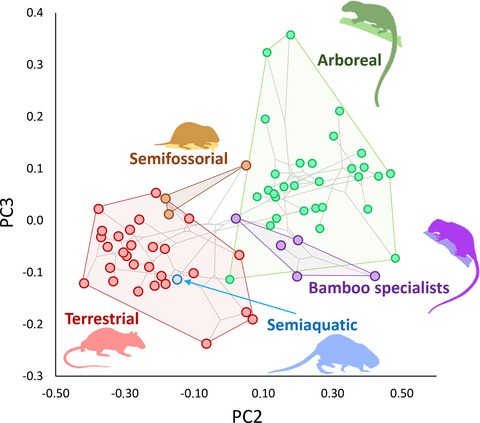
We analyzed effects of phylogeny and ecology on external morphology along echimyid radiation, showing that variation of all analyzed traits were phylogenetically structured and strongly correlated with size. Moreover, variation of tail, ear, and hindfeet lengths was associated with locomotory specializations, while some lineages showed shifts in evolutionary rates associated with changes in locomotory habits. Evolutionary changes in ear and hindfeet were mainly concentrated during early echimyid diversification, concomitantly with the emergence of most locomotory habits.
Track analysis of the Nearctic region: Identifying complex areas with mammals
- Pages: 466-477
- First Published: 06 February 2018
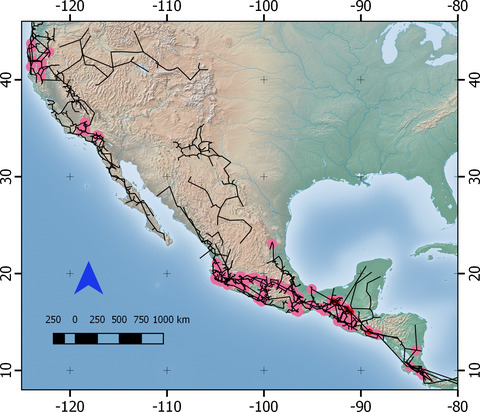
A track analysis was performed in the Nearctic region, to identify generalized tracks and panbiogeographic nodes. Seven generalized tracks with nested patterns were identified: California, Columbia Plateau, Mesoamerican, Mexican Plateau, Neotropic, Southern Rocky Mountains, and Western Coast of USA. Nine panbiogeographic nodes (in red) were identified, located in the Sierra of Chiapas and Central America. In addition, other 192 nodes (in pink) were identified for the nested patterns. The panbiogeographic nodes predicted areas with high evolutionary–geologic complexity.




